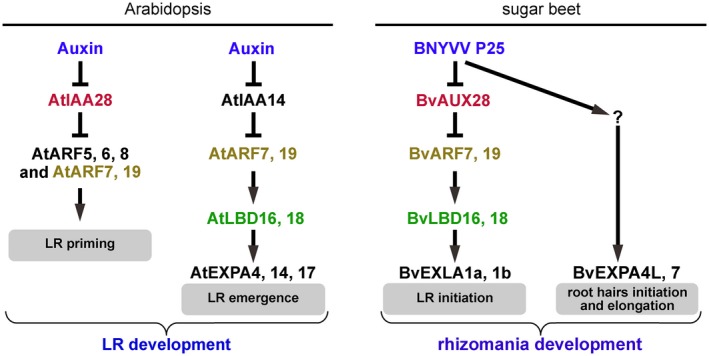Figure 7.

Proposed regulatory model for rhizomania development. In healthy Arabidopsis plants, auxin controls lateral root (LR) development through multiple auxin signalling modules. Two modules involved in LR development are shown in the left panel (modified from Lavenus et al., 2013 and Lee et al., 2015). LR founder cell priming involves the AtIAA28‐AtARF5, 6, 7, 8, 19 module. LR emergence is controlled by the AtIAA14‐AtARF7, 19 module. AtLBD16, 18 regulate LR emergence downstream of AtARF7, 19. In sugar beet, following Beet necrotic yellow vein virus (BNYVV) infection, the P25 virulence factor is produced. P25 inactivates BvAUX28 transcriptional repressor leading to the derepression of BvARF7, 19 transcriptional activators. Subsequently, the expression of a number of their target genes is turned on, including BvLBD16 and BvLBD18 transcription factors (TFs) involved in LR formation. BvLBD16, 18 activate the expression of two EXLA1 genes to facilitate cell wall (CW) relaxation and remodelling during LR initiation and emergence. The up‐regulation of the positive regulators of LR formation, BvLBD16 and BvLBD18, as well as EXPANSIN genes (EXPs), leads to the uncontrolled formation of LR, giving a ‘hairy root’ appearance of rhizomania‐afflicted sugar beet taproot. Meanwhile, another pathway is turned on leading to the activation of root hair (RH)‐specific EXPs, BvEXPA4L and BvEXPA7, to promote RH initiation and elongation. The formation of LRs and RHs is beneficial for the propagation of Polymyxa betae, the formation of zoospores and, ultimately, the efficient transmission of BNYVV. Auxin and P25 are shown in blue. The proteins encoded by homologous genes in Arabidopsis and sugar beet are shown by similar colours.
